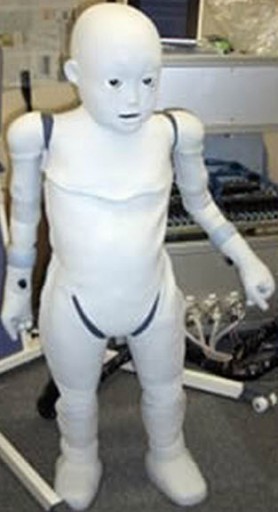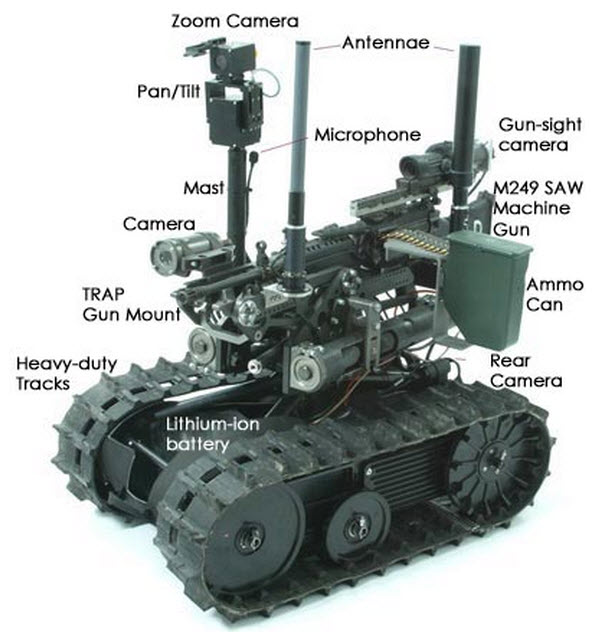book review | Science fiction bots becoming fact
March 3, 2011
An interview with Mark Stephen Meadows, author of We, Robot: Skywalker’s Hand, Blade Runners, Iron Man, Slutbots, and How Fiction Became Fact.
 With We, Robot (Lyons Press, 2010), Mark Stephen Meadows explores the recent edges of robotic development in the context of some of our favorite fictional narratives.
With We, Robot (Lyons Press, 2010), Mark Stephen Meadows explores the recent edges of robotic development in the context of some of our favorite fictional narratives.
It’s a smart, edgy read, written in a very hip, almost cyberpunk style (for one example, the author describes himself arriving in Tokyo, dropping two hits of codeine — no medical excuse required — and striding out into the neon lit night-time street in his leather jacket grooving on the strangeness of it all in search of signs of bot/human integration).
Meadows spent time at Xerox PARC as an artist and researcher,focusing on interactive reading and narration and SRI, working as a researcher in the intelligence and linguistics group. He shares patents related to artificial intelligence and virtual reality and brings the understanding of a technologist and the insight of an artist into his written work.
Aside from his other books, including I, Avatar: The Culture and Consequences of Having a Second Life, Meadows is known for his imaginative artwork, which has been displayed in galleries across the U.S. and Europe. An adventurer, he hitchhiked to Baghdad in 2003.
R.U. Sirius: Describe what inspired you to write this book. Was there a particular moment or thing or release that made you feel that robotic fact was starting to match science fiction in a particularly interesting way?
Mark Stephen Meadows: The book probably started, what … more than ten years ago? I wrote it to explore some ethical questions. And yeah, there was a particular day, or week, when things got weird.
It was in 2006, I guess, and I was really into watching Battlestar Galactica (partly because of them hot fembots). Of course I had noticed that the cylons had changed since last I’d seen them in 1979. The cylons were really human-like. Number 6 (Patricia Helfer) in particular, was no rigid-armed midget walking into walls.
I realized that the robots of science fiction had managed to climb their way right out of the uncanny valley. The more modern the science fiction, the higher out of the valley they’d climbed. This caused me to notice that science fiction was mapping to the uncanny valley — a theory about real robotics.

The Uncanny Valley. (Based on an image by Masahiro Mori and Karl MacDorman; license: Creative Commons)
Well, around this same time, I’d launched a couple of software companies, one of them dedicated to natural language processing (NLP), and I was doing some research for this company on the subject of uncanny valleys, specifically in language.
We were looking at how language is interpreted by an end-user; how language can be used for psychographic profiling and for interpreting desires; and how to not only extract desires from the language of an end-user, but to reflect it back and control those same desires in the end-user.
Now, this is something that any five-year-old knows (when she wants her parent to buy her a candy bar), and this is what Google knows too (when it wants a user to click on a link). It’s part of life, right? But we were making these chat-bot devices, software robots, that were being designed to control people. We needed the language to seem normal to better control people — to make the software robot more convincing. And if you’re inventing technologies that control people… well, there liveth ethical and moral questions!
So during that week in 2006, when I really decided to write this book, I saw, on one side, Tricia Helfer whispering into Balthazar’s ear, and on the other side, software whispering into my own ear. And I realized that as the uncanny valley is scaled so, too, there is a hilltop of control. The tools we will use to control our robots — language, mostly — are the same tools we use to control one another today. The controller and controllee is, on both ends, a human.
I realized then that there was no difference between us and robots. I mean, it’s not like robots are some magic kinder-race of superbytes we are creating that will soon rise up and, regardless of our wishes, overthrow humanity. But rather, I realized, robots are a puppet-tool we’ve mythicized. And I wanted to get to the bottom of it, or at least confuse my readers and myself by trying. So I guess Tricia Helfer was my muse?
RU: Please give us a quick capsule description of the technology related to the fictions referenced in your subtitle
MSM: These technologies are both factual and fictional.
Iron Man: this is mostly in Chapter 4 and includes: Cyberdyne’s HAL suit, Honda’s walking assistant, Lockheed’s Human Universal Load Carrier (HULC) system, Raytheon’s XOS battle system, U.S. military patents for bullet-dodging exoskeletons, and other weird stuff: like how these systems are controlled via electroencephalography (EEG), brain-machine interfaces (BMI), near-infrared spectroscopy (NIRS), and so on.
Oh, and I digress into the curious world of autonomous vehicles for a bit, too, since Shellhead’s a semi-autonomous vehicle, too, right?
Skywalker’s Hand: This robotic limb theme makes a few appearances in Chapters 1, 4, 6, 8. The best example for this is the work at the U.S. Veterans Health Administration. They’re working with Dean Kamen on the Deka Arm, nicknamed “Luke,” which is, well … Skywalker’s hand. Only without Skywalker.
The book also looks at Kevin Warwick’s robotic implant experiments, the LifeHand Project at the Biomedical University in Rome, Cyberglove, and nearly a half dozen other examples.
Blade Runner: This is mostly in Chapter 5. Here the book gets into the Voigt-Kampff Altered Scale, and emotional measurement systems. We start by looking at android design, emotional perception, sex with robots, and we do it mostly through the research of AIST, in Tokyo.
Then we find out about a slew of robots including CB2, Kismet, Kansai, JAST, EveR-2Muse, David McGoran’s Heart Robot, and others.
Ok, whew … but finally, Blade Runner is about how robots are measuring us, and this is really important to the whole book. We look primarily to Google for that, but discuss other technologies as well, such as Innerscope, AdKnowledge, and so on.
Slutbots: Pris in Blade Runner is hardware in fiction; today most slutbots are software. But I found this interesting because exceptions are appearing like Real Companion, which is a pleasure-sex robot. We might call RealDoll a robot, but the management there was very much opposed to my using their product in the book. I’m a big fan of RealDoll. I am proud to say I had a boobie-ball in 1995. That stuff is incredibly weird and funny. Can’t wait until it starts talking.
RU: You mention that the idea for this book started around ten years ago. How would you describe the rate of progress in robotics over that time and what is most impressive?
MSM: It’s always been increasing, but now it’s increasing at such a rate that we’ll see serious funding, serious media attention, and serious companies lining up to make sure this development rolls forward. This started to happen in 2007. And then the financial collapses cost the industry a hit or two, but it’s coming back up and I think the coming three years will be pretty interesting.
It’s been said by Bill Gates that robotics development today is a revolution in computers much like what happened with personal computers in the 1970s and 80s. Robots today, like desktop computers then, have traditionally been used in large, industrial corporations. Now we’re developing applications in the home, and those applications are creating a shift in public interest. That will fertilize growth in the industry.
Personal computers helped humanity make great strides, and I’m sure robots will as well, particularly when it comes to porn and warfare.
RU: Early on in the book, you have an interesting and intense section on bots in the military. What are the most promising, strangest, and/or most frightening developments in recent years?
MSM: I’m tempted to say that it is how war is being revolutionized. Just as the machine gun changed war, robots will have an even larger impact (Please read P. W. Singer’s Wired For War if you’d like more on this). But it’s not the change in warfare that is the most strange and frightening, nor even the change in the socioeconomics of war, but actually the change in the value of human heartbeats.
See, if we send robots in to do the dirty work of war — just ship ’em off to some foreign land and run ’em remote — we can get the job done more cheaply, and up our profit-to-cost ratio. Robots don’t have leave time, kids, wounds, or moral issues. So, in war, robots are becoming more valuable than humans (and anyway, it’s good business back home if a robot is blown up). The robot ups the value of a soldier’s life, and it also reduces the cost of killing an enemy combatant.
What’s strange and frightening is that this is true in factories, as well. If we send robots in to do the dirty work of factories — just ship ’em off, etc. This is because most assembly-line robots in Japan cost about two or three years’ salary, if you pay a human to do the same job. So the cost of a robot amortizes over about 36 months (it varies, of course). Again, robots don’t have vacations, kids, colds, or complaints about working conditions. So, in factories, robots are now more valuable than humans. They get more done for less, just like on the battlefield.
These and other data points indicate to me that robots are changing the value of human life (footnote: the value of money and time also are getting redefined, as they have since the early parts of the industrial revolution, but I’ll save that conversation for another book).
The obviously promising part of this is that robots will allow us more time to do stuff other than shoot people and stamp out auto parts. Yay! However, in the big picture, if we look not at a country (say the United States, or China) that has lots of robots, but at humanity overall, I don’t see robots doing as much good as harm because they are a powerful tool that will cause increased inequality of important stuff like money, leisure time, longevity, et cetera. Robots will allow richer countries to become increasingly rich, and most revolutions in the history of the world stem from these kinds of inequalities.
It boils down to how we apply value to the automation of human labor. Ultimately, it is not the robot that’s important, it’s how we use the robot. So the promise is as strange as it is frightening.
I, for one, welcome our new robot overlords. And I welcome them skeptically, because down deep, they’re us.




